Pros
Cons
Introduction
Front
{{section_header}}{{section.name}}{{/section_header}}

Back
{{section_header}}{{section.name}}{{/section_header}}

Sides
{{section_header}}{{section.name}}{{/section_header}}

Top
{{section_header}}{{section.name}}{{/section_header}}

Bottom
{{section_header}}{{section.name}}{{/section_header}}

In the Box
{{section_header}}{{section.name}}{{/section_header}}

The contents of the G11 box
- The G11 Camera
- CB-2LZ battery charger
- NB-7L battery
- USB cable
- Analog video out cable
- Neck strap
- User Guide
- Software CD
Color
{{section_header}}{{section.name}}{{/section_header}}
In this test, we look at how accurately the G11 can capture color. The results show that the camera did a decent job of capturing colors, although it had some issues with some colors; greens and reds were a little off. The colors were also a little oversaturated, but not excessively so. More on how we test color.
The G11 has a wide range of color modes (Canon refers to them as My Color modes), but we found that selecting the Off mode produced the most accurate colors. The Natural mode also produced very accurate color, but the images were a little under saturated. The other modes processed the colors in various ways: the Vivid mode boosted the saturation, and the Light Skin mode lightened skin tones. You can see examples of all of the color modes in the controls section of this review.
Color Modes
{{section_header}}{{section.name}}{{/section_header}}
The G11 has a lot of color modes on offer: as well as turning the color mode off, you can choose from Vivid, Neutral, Sepia, Black & White, Positive Film, Lighter Skin Tone, Darker Skin Tone, Vivid Blue, Vivid Green and Vivid Red. Finally, there is a custom mode which allows you to set levels for contrast, sharpness, saturation, red, green, blue and skin tone.
Noise
{{section_header}}{{section.name}}{{/section_header}}
Noise is the stuff that shows up in photos as a grainy patina on your images, which can ruin an otherwise good image. All digital cameras introduce some noise into images, but good ones keep this to a minimum. We found that the G11 did a good job here: although it has a very wide ISO range, noise didn't become a big issue until we cranked the ISO up to 800 and higher. We test point and shoot cameras at two light levels: 3000 lux (about the same as outdoors on a cloudy day) and60 lux (about the same amount of light as you would get from indoor lighting). The G11 had lower noise when shooting in the brighter setting, but the two sets of results are not significantly different. More on how we test noise.
Overall, the G11 performed well in our noise tests, producing just a small amount of noise in the ISO range of 80 to 800. The noise was significant in the 800 to 3200 range, but it was still significantly less than other cameras.
If we compare the performance of the G11 with other cameras, you can see that it does a decent job of keeping the noise low across the ISO range.
{{comparison_bars title="Noise Score Comparison", attribute="Noise Score", xLabel="Noise Score"}}
ISO
{{section_header}}{{section.name}}{{/section_header}}
The G11 has a wide ISO range, starting at 80 and going up to 3200, all while maintaining the full resolution of the camera. In addition, a dedicated low light mode is available which increases the ISO to 12800, but at the cost of reduced resolution: t the image size in this mode is restricted to 1824 by 1368 pixels. An example of a photo taken in this mode is in the controls section.
NOTE: The images above are not used in our testing or scoring, but are included here to show real-world examples of the differences between cameras at the various ISO settings.
Resolution
{{section_header}}{{section.name}}{{/section_header}}
The G11 scored very highly on our tests of the resolution of images: in our tests, the images were consistently sharp across the zoom range and had low chromatic aberration. The only issue that we saw was some distortion at the wider end of the zoom range. More on how we test resolution.
Distortion ({{product.raw_scores['Distortion Score']}})
The lens of the G11 added very little distortion to the images at most points on the zoom range: we measured it at less than 0.8 percent in the middle, and less than 0.3 percent at the telephoto end of the zoom range. There was more significant distortion at the wide end of the zoom range, though; just under 3 percent, which is a lot. You can see an example of this below.
Sharpness ({{product.raw_scores['Sharpness Score']}})
The G11 had excellent sharpness in our test images: we found that the camera did an excellent job of capturing fine detail across the zoom range. Most cameras tend to get a little soft at one or other end of the zoo, but the G11 remained consistent across the range. We did see some evidence of the images taken at the wide end of the zoom range getting a little soft at the edges, but this was much less pronounced than in other cameras.
Chromatic Aberration ({{product.raw_scores['Chromatic Aberration Score']}})
The G11 also did well in our tests on the chromatic aberration of the lens: we saw only very small amounts of the color fringing that indicates that the optics of the lens are diffracting the colors of light differently. There was some evidence of some aberration on the images shot at the widest settings of the zoom lens, but this was very minimal.
Quality & Size Options
{{section_header}}{{section.name}}{{/section_header}}
The G11 offers a wide selection of options for image size and quality: 6 different sizes of image and 3 levels of image quality. One of these options is to save images as RAW images, which saves all of the data from the image sensor. These images are large, but they are the best for editing images. One feature that is missing here is the ability to save images as both RAW and JPEG format, which some cameras can do.
Image Stabilization
{{section_header}}{{section.name}}{{/section_header}}
The G11 includes an optical image stabilization system, which moves a part of the lens to try and correct for hand shake. We found that this system did improve the sharpness of images taken when the camera was moving, but not by a huge amount. We test this by setting the camera to a shutter speed of 1/30 of a second, shaking the camera with our stabilization system and measuring the sharpness of the images it captures. We run this test with the stabilization system on and off, and measuring the difference it makes. More on how we test image stabilization.
Video Mode
{{section_header}}{{section.name}}{{/section_header}}
The movie mode of the G11 feels like something of an afterthought. The camera can capture video, but only at a 640 by 480 resolution, with relatively few options or controls on offer. You can't use the optical zoom of the lens while recording (although you can use it before recording, and a 4x digital zoom is available while recording), and the sound that is captured is only mono. Videos are compressed into .MOV files that can be played back in Apple's Quicktime software and which are suitable for uploading to video sharing sites like YouTube.
One thing to note here is that the G11 does include a mini HDMI port for connecting it to a HDTV, but it only captures standard definition video.
Video Color
{{section_header}}{{section.name}}{{/section_header}}
We found that the G11 captured decent color, although it was a little oversaturated. There were a few shifts from the original, though; subtle blues and greens were more vivid than they should be. More on how we test video color.
{{comparison_bars title="Video Color Score Comparison", attribute="Video Color Score", xLabel="Video Color Score"}}
Video Sharpness
{{section_header}}{{section.name}}{{/section_header}}
For a camera that shoots video at 640 by 480 resolution, the G11 had decent sharpness; fine details were decently captured, although the low resolution of the video compared to high definition video means that it is not going to capture the detail that a HD camera will. We test this by videoing a special chart, panning the cameras and analyzing the captured video to see how well the detail of the chart is represented. More on how we test video sharpness.
{{comparison_bars title="Video Color Sharpness Comparison", attribute="Video Sharpness Score", xLabel="Video Sharpness Score"}}
Playback Mode
{{section_header}}{{section.name}}{{/section_header}}
Pressing the playback button on the G11 puts it into a playback mode. In this mode, you can look at photos in a number of ways, including up to 36 thumbnails and zooming in up to 10x. You can also view a number of different levels of information on the images.
In-Camera Editing
{{section_header}}{{section.name}}{{/section_header}}
Basic editing features are on offer from the main menu of the G11; images can be cropped, re sized and have red-eye removed. You can also apply all of the color effects that are described in the Color section. Also offered is Canon's own i-Contrast processing, which tries to correct for under or over exposure of images. It does a pretty decent job, as well.
Direct Print Options
{{section_header}}{{section.name}}{{/section_header}}
The standard features for printing photos are included. Photos can be tagged for printing by pressing the short cut button on the back of the camera, which flags the image for printing using the DPOF image format. The G11 can also be connected directly to any printer that supports the common PictBridge standard, where the camera connects to the printer over a USB cable. This means that you can print photos without using a computer.
Viewfinder
{{section_header}}{{section.name}}{{/section_header}}
The viewfinder of the G11 is an old-school rangefinder type; rather than use the camera lens, you see an image created from a separate set of lenses in the camera body. This is both a good and a bad thing. On the upside, it does not use any battery power, works well in all lighting conditions and has a certain retro charm. On the downside is the fact that the image you see in it is not the same as what the camera sees because the position of the lens is different. This is especially true with macro shots and other closeups; the framing of the viewfinder for objects close to the lens will be very different between the viewfinder and the camera sensor. The viewfinder is also rather awkward to use, as you have to get close to the to use it, and you end up squashing your nose against the screen. At the widest zoom setting, you can also see the top edge of the lens in the frame, which is very distracting. It doesn't appear in the captured images.
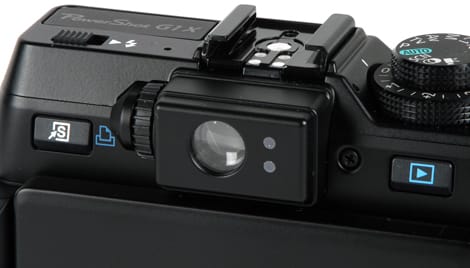

... and it has a diopter adjustment ring.
Display
{{section_header}}{{section.name}}{{/section_header}}
The LCD of the G11 is a 2.8-inch model with about 460k pixels. It is located on a pivot that allows it to flip out and rotate about 270 degrees. This means that you can store it flat against the body, rotate it to lie flat like a normal LCD screen or angle it for shooting from above or below. Although the screen is not as big as some we've seen, it is bright and clear and does a good job of showing both the preview of photos to be taken and to play back photos.

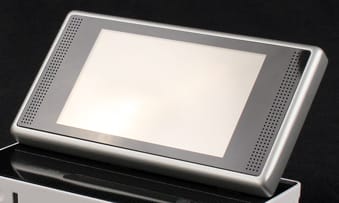
...but it turns into a nice 3-inch widescreen in playback mode.
Flash
{{section_header}}{{section.name}}{{/section_header}}
The flash of the G11 is built into the body of the camera and is located just above and to the right of the lens. We found that it was a pretty powerful flash that could illuminate objects up to about 9 to 11 feet distant, but the proximity of the lens to the flash does mean that it produces quite a lot of red eye. This can be partly ameliorated by the use of the red-eye reduction light and a pre-flash mode, but it is still present in many images.
If the built in flash isn't up to the task, the G11 does include a flash shoe that allows a larger, more powerful external flash to be used: the HF-DC1. This $130 flash unit works with a range of Canon PowerShot models, or you can use any flashgun with a standard shoe.

The flash emitter pops up from the top of the body via a mechanical release.
Lens
{{section_header}}{{section.name}}{{/section_header}}
The lens of the G11 is made by Canon themselves and has a focal length of 6.1 to 30.5mm, which represents a zoom length of 5X. That's equivalent to a zoom length of 28 to 140mm on a 35mm film camera.

That's a decent zoom range for a point and shoot camera, and it is good to see that the wide end of the zoom range starts at 28mm, which means you can get in large groups of people or landscapes. However, the telephoto end is a little shorter than some, so you can't get as close in on the action as some. In the examples below, cameras with longer zooms can get right in to see what is showing at the theater. The G11 can't quite manage that.
Although the lens is fixed, there is an adapter available that lengthens the focal length of the lens. The $40 LA-DC58K conversion lens adapter allows you to connect a telephoto converter, the $150 TC-DC58D. This increases the focal length of the lens by 1.4x.
Battery
{{section_header}}{{section.name}}{{/section_header}}
The G11 gets its juice from an NB-7L Li-ion battery that holds about 7.8 Wh of charge. This battery has to be removed from the camera to be charged, and Canon will charge you $70 for a spare.

Memory
{{section_header}}{{section.name}}{{/section_header}}
The G11 stashes its images on SD or SDHC memory cards. Canon did not specify the largest size of SDHC card that is supported, but the G11 should be fine with even the 32GB cards that are now available. You may need this support for larger cards, as the RAW images that this camera can shoot are rather large: typically between 11 and 15MB. If you shoot in the RAW+JPEG mode, that means that you'll be able to fit just around 113 images onto a 2GB card.

Jacks, Ports & Plugs
{{section_header}}{{section.name}}{{/section_header}}
There are just two ports on the G11: a mini HDMI port for connecting to a HDTV, a remote port and one that performs multiple functions. This bottom port doubles as an analog A/V output and a USB connection. The cable to allow this port to be connected to a standard definition analog TV is included, as is a USB cable. We are also pleased to see that Canon has managed to pull this off while keeping it compatible with standard USB cables; you can use any USB cable with a mini-A USB plug. This means that if you loose the included one, you won't have to spend a fortune to buy a replacement.
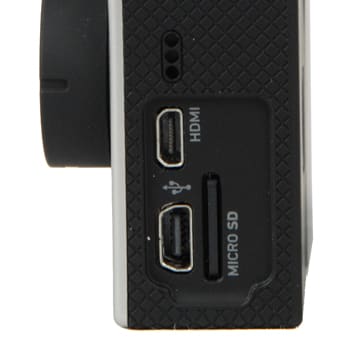
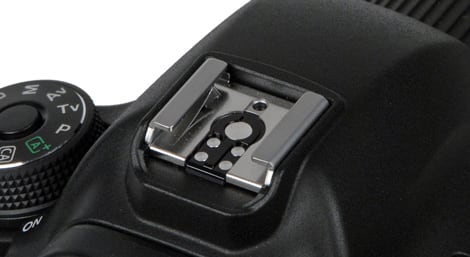
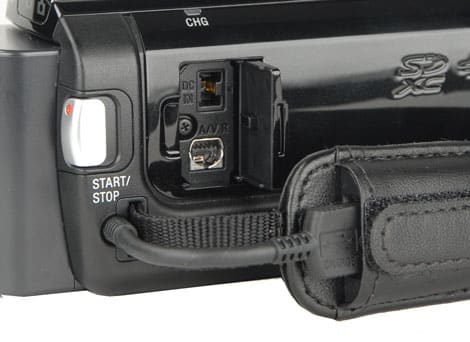
The DC-input and multi-AV port are located on the right side of the camcorder.
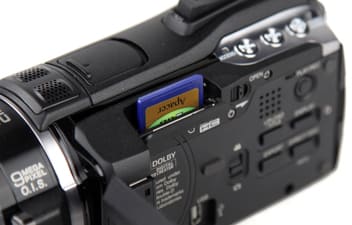
... as is the SD/SDHC card slot.
Shooting Modes
{{section_header}}{{section.name}}{{/section_header}}
The G11 has a very wide selection of shooting modes on offer, including a full manual mode and 20 scene modes. Most of these scene modes are available by setting the mode dial to SCN and using the scrolling control to move through the list, but some (low light and quick shot) have their own spots on the mode dial. Using the scene mode spot on the dial is a bit awkward; you have to scroll through the list with no indication of how far to go to find the mode you want.
For the more seasoned shooter, there are also a good selection of manual modes, including aperture and shutter priority and a full manual modes. Two spots on the mode dial are also reserved for custom modes that can hold a group of settings. This is a very useful feature to have if you move quickly from one shooting situation to another. For instance; if you are shooting at an indoors and outdoors wedding, you could have one custom mode for indoors (with flash turned on, white balance in flash mode, etc) and another for outdoors (flash disabled, white balance to daylight, shutter priority mode, etc). Switching from one to the other is as simple as turning the dial to the C1 or C2 spot.
Auto Mode Features
Focus - We found the auto focus on the G11 to be very quick and responsive; the camera quickly found the focus point in most situations. The G11 uses a single focus point (rather than the multiple focus points of some cameras), but you can move this point and change the size. This means that if you are focusing on something that is off center, you have to move the focus point by pressing the AF frame selector button and using the directional pad the move the focus square. You can also change the size of the focus square; two sizes are available. In low light, it uses an AF assist light in the form of a white LED with a smaller blue patch in the center. This light is rather bright, so it should be used with caution; you could blind people. It can be turned off if required.
Exposure - You get a lot of control over the exposure process of the G11: you can quickly set up to 2 stops of compensation either way with the compensation dial on the top of the camera. Several exposure bracketing features are also available; you can set the camera to take 3 shots at up to +/-2 stops of exposure compensation, as well as focus bracketing which takes 3 images at different focus points.
Metering - The G11 offers the standard set of metering modes: evaluative, center weighted and spot. A face detection mode is also available which uses the detected faces for focus and exposure.
Self-Timer - The G11 offers a lot of options in its self timer feature. As well as the usual simple 10 and 2 second delays, the camera can take a number of photos (from 3 to 10) when it detects a face in the frame. There is also a custom option which allows you to set the delay (up to 30 seconds) and the number of shots that are taken (from 3 to 10). The one thing that is missing is an interval timer, where the camera takes a number of shots at a preset time interval.

The full mode dial is nice, but frequently rotates by accident.
Picture Effects
{{section_header}}{{section.name}}{{/section_header}}
A lot of picture effects are on offer, including a wide range of color modes and other effects.
The color accent and color swap modes can also be used when shooting video, and both provide some degree of customization; using the control dial, you can control how precise the color match is for both modes.
Manual Controls
{{section_header}}{{section.name}}{{/section_header}}
Manual focus is available by pressing the up section of the directional pad, and we found this to be easy to use; you focus with the control wheel, and the camera enlarges the center of the image on the LED screen to check focus.
The G11 offers a lot of control over the white balance settings it uses to take photos; there are 7 presets, two custom settings and a full auto mode. All of these can be fine tuned as required, which is unusual for a point and shoot. Having two custom settings is also unusual, but is very useful if you want to use a custom setting from two locations.
The full manual and aperture priority modes of the G11 give you a good degree of control over the aperture settings of the lens, although the lens has a rather limited aperture range, especially at the telephoto end of the zoom range.
A good degree of control over the shutter speeds of the camera is also available, and the G11 offers a good range of shutter speeds, from 1/4000 down to 15 seconds.
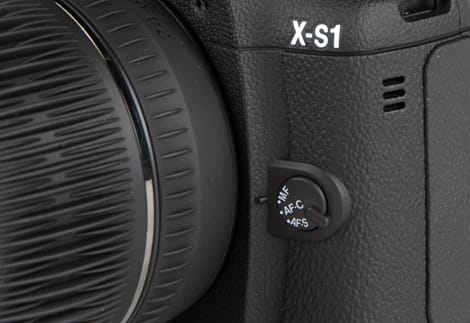
A dedicated focus-mode switch on the front panel.
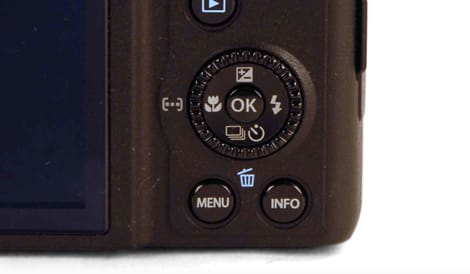
The scroll wheel surrounding the d-pad is neither awful nor perfect.
Drive/Burst Mode
{{section_header}}{{section.name}}{{/section_header}}
Two burst modes are available on the G11: continuous shooting and continuous shooting AF. In the latter mode, the camera continuously keeps checking the focus point and adjusting it if required.
Shot to Shot ({{product.raw_scores['Shot to Shot Score']}})
In our tests, we found that the G11 was capable of shooting about 1 frame a second at the highest resolution in the continuous shooting mode. The continuous shooting AF mode is a little slower, at 0.77 frames a second. That's a little slow, but the camera is at least capable of taking a lot of shots at this speed, as it can write the images out to the memory card as fast as it takes them.
Handling
{{section_header}}{{section.name}}{{/section_header}}
Although the G11 is on the chunky side, it fits into the hand well, with the raised grip on the front of the body providing sufficient room for the fingers to hold on tightly, and a textured rubber coating on this grip means that it won't slip from sweaty fingers. Another level of security is provided by the inclusion of a wrist strap with the camera.




These dedicated buttons give you quick access to aperture and shutter speed controls.
Buttons & Dials
{{section_header}}{{section.name}}{{/section_header}}
There are a lot of buttons and dials on the G11: a total of 14 buttons and and 5 dials in all. This number of buttons could be confusing for newcomers, but it does make these controls much easier to access than other cameras. To change the ISO level on the G11, you just twist the ISO dial. On other cameras, you have to dig into the on-screen menu and find the ISO option, then change it.

The bulk of the G11 does mean that you have to use both hands to access the controls of this camera. Although the controls are near the shutter, you can't change the shooting mode or ISO level with one hand. The same is true of the exposure compensation dial and other controls on the back of the camera.
One interesting addition to the standard set of controls on the back is the control dial. Located around the 4-way directional pad, this makes it much easier to quickly scroll through menus and set options such as shutter speed. Rather than using the up and down of the directional pad, you can quickly scroll through the options with the control dial. It's a definite plus in manual modes, where it makes choosing a shutter speed or aperture much quicker.

Menus
{{section_header}}{{section.name}}{{/section_header}}
The G11 has two separate menu systems: the function menu for the basic functions of the camera and the main menu for the other controls. The function menu is accessed by pressing the func. button in the middle of the directional control pad, and contains the controls for the shooting features of the camera. The features that can be accessed here depend on the shooting mode, but in most they include the size of the images, white balance, bracketing, the burst mode and the neutral density filter.
The main menu is accessed by pressing the menu button, and contains the other functions of the camera. It's divided into three tabs: shooting settings, camera settings, and the customizable my menu settings. The shooting settings tab is for features such as enabling/disabling the digital zoom, setting the AF mode, etc. The camera settings menu is the home of features such as formatting the memory card, the power saving settings and others. The My Menus tab allows you to create a customized menu that contains commonly used features for quick access.
Manual & Learning
{{section_header}}{{section.name}}{{/section_header}}
The G11 comes with a 195 page manual that does a very good job of explaining the features of the camera, starting with the basic features and covering all of the more complex ones as well.
Samsung HZ15W Comparison
The Canon PowerShot G11 is the most expensive of these two cameras, by a quite considerable margin. And it also proved to be the superior performer in many of our tests, with lower noise and sharper images. But the ZS3 was the winner in others, with better image stabilization, and more accurate color. The ZS3 was also the superior performer in shooting video; it captures video at a higher resolution, with more detail and better color.
It's also a mixed race in terms of specifications: the ZS3 has a much longer zoom, which means it can get closer to the action. The two cameras shoot images at about the same 10-megapixel resolution and have a similar range of shooting modes, with both offering full manual modes. However, the manual mode of the G11 is much easier to use, with the several dials and buttons making setting options much easier.
If you are looking to choose between the two, the decider could be the need for video. If you don't need to shoot videos, the G11 shoots the better quality images. But if you want to shoot video more than occasionally, then the ZS3 may be the right pick.
Canon PowerShot SX120 IS Comparison
The G11is the more expensive camera, but both cameras performed very well in our tests. Both had excellent sharpness, but the G11 had less noise. The HZ15W, however, had more accurate color in both still images and video. It also had sharper video, so the HZ15W may be the better pick if you need to shoot a lot of video.
Both cameras also include full manual modes, but the G11 provides much easier access to the controls of this mode, thanks to the various dials and buttons on the top and the back of the camera.
COMP 3
The PowerShot SX120 is the big winner in terms of price: at $250, it is about half the price of the G11. But the SX120 was no slouch, scoring nearly equal or better than the G11 in our tests of noise, color and image stabilization. The G11 had the edge in our resolution tests, though, because the images remained sharp across the zoom range, while the images captured by the SX120 at the longer zoom settings were a little soft. It is worth noting that the SX120 has a longer zoom lens, though, going out to 10x rather than the 5x of the G11.
Conclusion
The Canon PowerShot G11 is a powerful camera that includes a lot of features. In many ways, it is more of an SLR camera than a point and shoot, as it includes the wider ISO range and more comprehensive manual controls that SLRs offer. And it puts these features right out there, with dedicated dials for exposure compensation and ISO on the top, plus a rather large number of buttons on the back. All of this will be welcomed by the serious shooter; they make controlling the camera much easier. They will intimidate the more novice user, though.
This puts the G11 into a curious middle ground. It has the feature set of an SLR, but does not have an interchangeable lens (although you can buy a wide angle and telephoto adapter). It is also bigger, bulkier and more awkward to use than a point and shoot camera: this camera is not going to fit into a pocket. But this mix of size and features could be appealing for the photographer who wants some level of control over their images, but without having to lug around an SLR.
However, the Achilles heel of the G11 is price. At around $500, it is only slightly cheaper than a low-end SLR, and with smaller SLRs like the Panasonic GF1 now available, the size difference is not that much. But the G11 is smaller and cheaper than these SLRs and if I was hiking the Appalachian trail or chasing bears in Yellowstone, I'd rather carry around the relatively compact G11 than a big, bulky and more expensive SLR.
Photo Gallery
{{photo_gallery "Front Photo", "Back Photo", "Sides Photo", "Top Photo", "Bottom Photo", "Lens Photo", "Flash Photo", "EVF Photo 1", "EVF Photo 2", "LCD Photo 1", "LCD Photo 2", "Media Photo", "Modes Photo", "Manual Controls Photo", "Manual Controls Photo 2", "Other Controls", "Buttons 1", "Buttons 2", "Other Hardware Photo", "Battery Photo", "Ports Photo 1", "Ports Photo 2", "Ports Photo 3", "Ports Photo 4", "Handling Photo 1", "Handling Photo 2", "Handling Photo 3", "Box Photo"}}
Meet the tester
Richard Baguley is a veteran writer who has written about technology ranging from Alphabet to Zip file utilities. He has contributed to pretty much every major tech publication, including Amiga Format Magazine, PC World, Wired, CNET, Toms Guide, Forbes, and many others. He lives in the Boston metro area with his wife, dog, and an indeterminate number of cats.
Checking our work.
Our team is here to help you buy the best stuff and love what you own. Our writers, editors, and experts obsess over the products we cover to make sure you're confident and satisfied. Have a different opinion about something we recommend? Email us and we'll compare notes.
Shoot us an email